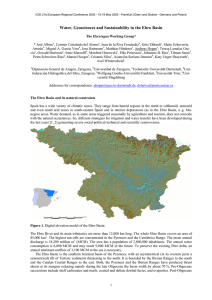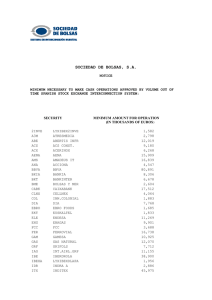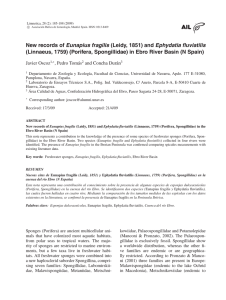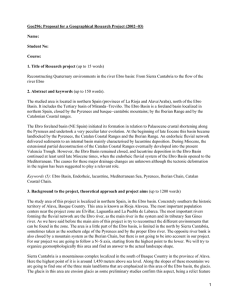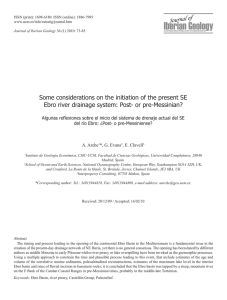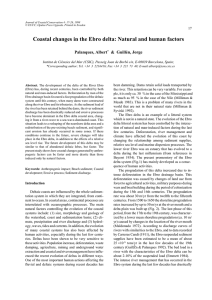Changes dissolved nutrients lower Ebro river
Anuncio
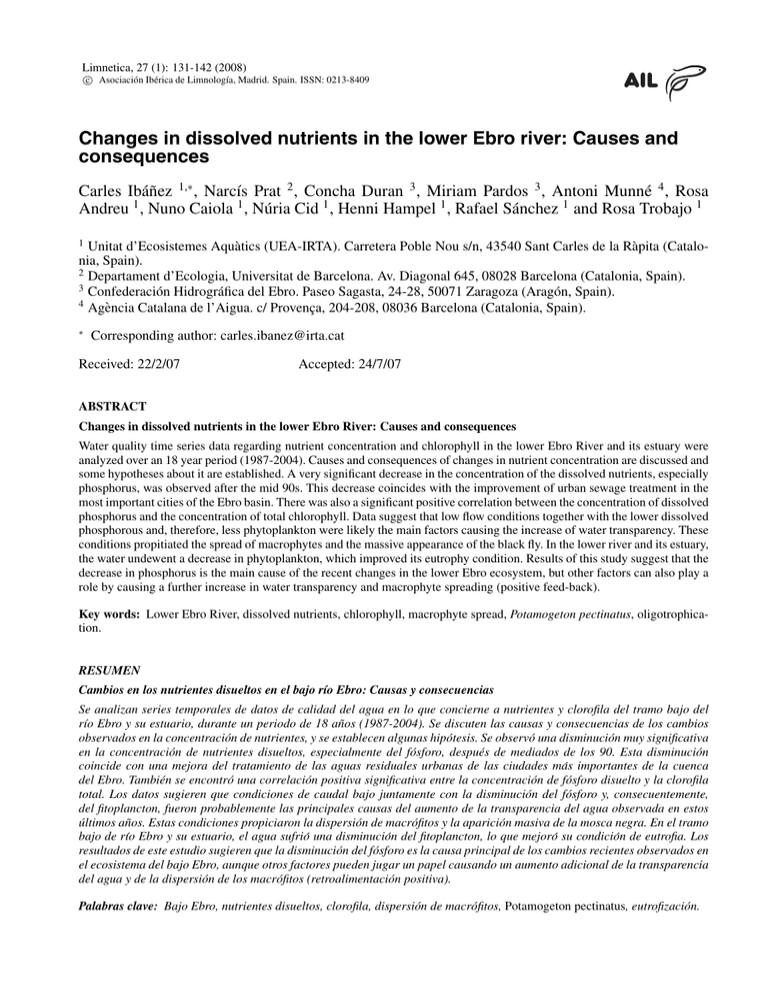
Limnetica, 27 (1): x-xx (2008) Limnetica, 27 (1): 131-142 (2008) c Asociación Ibérica de Limnologı́a, Madrid. Spain. ISSN: 0213-8409 Changes in dissolved nutrients in the lower Ebro river: Causes and consequences Carles Ibáñez 1,∗ , Narcı́s Prat 2 , Concha Duran 3 , Miriam Pardos 3 , Antoni Munné 4 , Rosa Andreu 1 , Nuno Caiola 1 , Núria Cid 1 , Henni Hampel 1 , Rafael Sánchez 1 and Rosa Trobajo 1 1 Unitat d’Ecosistemes Aquàtics (UEA-IRTA). Carretera Poble Nou s/n, 43540 Sant Carles de la Ràpita (Catalonia, Spain). 2 Departament d’Ecologia, Universitat de Barcelona. Av. Diagonal 645, 08028 Barcelona (Catalonia, Spain). 3 Confederación Hidrográfica del Ebro. Paseo Sagasta, 24-28, 50071 Zaragoza (Aragón, Spain). 4 Agència Catalana de l’Aigua. c/ Provença, 204-208, 08036 Barcelona (Catalonia, Spain). 2 ∗ Corresponding author: [email protected] 2 Received: 22/2/07 Accepted: 24/7/07 ABSTRACT Changes in dissolved nutrients in the lower Ebro River: Causes and consequences Water quality time series data regarding nutrient concentration and chlorophyll in the lower Ebro River and its estuary were analyzed over an 18 year period (1987-2004). Causes and consequences of changes in nutrient concentration are discussed and some hypotheses about it are established. A very significant decrease in the concentration of the dissolved nutrients, especially phosphorus, was observed after the mid 90s. This decrease coincides with the improvement of urban sewage treatment in the most important cities of the Ebro basin. There was also a significant positive correlation between the concentration of dissolved phosphorus and the concentration of total chlorophyll. Data suggest that low flow conditions together with the lower dissolved phosphorous and, therefore, less phytoplankton were likely the main factors causing the increase of water transparency. These conditions propitiated the spread of macrophytes and the massive appearance of the black fly. In the lower river and its estuary, the water undewent a decrease in phytoplankton, which improved its eutrophy condition. Results of this study suggest that the decrease in phosphorus is the main cause of the recent changes in the lower Ebro ecosystem, but other factors can also play a role by causing a further increase in water transparency and macrophyte spreading (positive feed-back). Key words: Lower Ebro River, dissolved nutrients, chlorophyll, macrophyte spread, Potamogeton pectinatus, oligotrophication. RESUMEN Cambios en los nutrientes disueltos en el bajo rı́o Ebro: Causas y consecuencias Se analizan series temporales de datos de calidad del agua en lo que concierne a nutrientes y clorofila del tramo bajo del rı́o Ebro y su estuario, durante un periodo de 18 años (1987-2004). Se discuten las causas y consecuencias de los cambios observados en la concentración de nutrientes, y se establecen algunas hipótesis. Se observó una disminución muy significativa en la concentración de nutrientes disueltos, especialmente del fósforo, después de mediados de los 90. Esta disminución coincide con una mejora del tratamiento de las aguas residuales urbanas de las ciudades más importantes de la cuenca del Ebro. También se encontró una correlación positiva significativa entre la concentración de fósforo disuelto y la clorofila total. Los datos sugieren que condiciones de caudal bajo juntamente con la disminución del fósforo y, consecuentemente, del fitoplancton, fueron probablemente las principales causas del aumento de la transparencia del agua observada en estos últimos años. Estas condiciones propiciaron la dispersión de macrófitos y la aparición masiva de la mosca negra. En el tramo bajo de rı́o Ebro y su estuario, el agua sufrió una disminución del fitoplancton, lo que mejoró su condición de eutrofia. Los resultados de este estudio sugieren que la disminución del fósforo es la causa principal de los cambios recientes observados en el ecosistema del bajo Ebro, aunque otros factores pueden jugar un papel causando un aumento adicional de la transparencia del agua y de la dispersión de los macrófitos (retroalimentación positiva). Palabras clave: Bajo Ebro, nutrientes disueltos, clorofila, dispersión de macrófitos, Potamogeton pectinatus, eutrofización. 132 Ibañez et al. INTRODUCTION Nutrient content and loading of rivers has changed in the last decades due to increasing human population and economic activities. The general trend has been an increase in nutrients due to fertilizers and urban wastewater, among other causes, but more recently some eutrophicated rivers have undergone a decrease in N and P due to an improvement in water treatment and crop management (Kronvang et al., 2005). In some cases, the reduction of farming activity and fertilizer has caused a significant decrease in the nutrient concentration of rivers (Stalnacke et al., 2003). Water quality monitoring programmes in many watersheds have recorded data on dissolved nutrients (rather than particulate) during several decades, so it is nowadays possible to carry out analyses of periods long enough to show significant changes in concentration and loading. Most of the existing studies of rivers show an increase in nutrient loading and concentration until the 80’s and an ulterior stabilization or decrease due to an improvement in water management (Radach & Patsch, 2007; Littlewood & Marsh, 2005). Although the process of eutrophication is reasonably understood in lakes, there is currently no conceptual understanding of how eutrophication develops in rivers (Hilton et al., 2006). Nutrient enrichment in rivers and estuaries often implies an increase in algal biomass, either phytoplankton, phytobenthos, macrophytes, or macroalgae (Marques et al., 2003; Nijboer & Verdonschot, 2004), depending on local conditions not well understood yet. Still less studied and understood are the effects of nutrient reduction in rivers and estuaries, a process occurring in a growing number of watersheds in developed countries as a consequence of recent water policies directed to reduce eutrophication (Kronvang et al., 2005). The effects of oligotrophication are better understood in lakes (Jeppesen et al., 2002). There is no data on nutrient concentrations and primary producers for the original reference conditions in the lower Ebro River and its estuary. However, it is known that, prior to river regulation, big floods and high concentrations of inorganic suspended sediments (caused by fre- quent floods) were common in the lower Ebro (Ibáñez et al., 1996), preventing a significant development of both phytoplankton and macrophytes. Existing data from the last decades show that the eutrophication process started about 3040 years ago (Bouza et al., 2006; Ibáñez et al., 1995; Muñoz & Prat, 1990; Prat et al., 1988), preceded by the development of a high number of dams and irrigation projects. The increasing population, economic activity and per capita water consumption during this period has also contributed to the nutrient enrichment of the lower Ebro River and delta. Recently, there is a trend of reduced nutrient loading likely due to improved water treatment and land management (Torrecilla et al., 2005), but the possible response of the lower Ebro River and its estuary to nutrient reduction (higher water transparency, macrophyte spreading, etc.) has not yet been established. The main objectives of this paper are: • To analyse changes in dissolved nutrients and eutrophication status of the lower Ebro river during the last 20 years. • To establish and discuss some hypotheses about the possible causes and consequences of these changes. • To establish and discuss some hypotheses about the role of nutrient reduction in the ecosystem changes recently observed in the lower Ebro River. METHODS Study area The Ebro basin is located in the NE of the Iberian Peninsula, with a surface of 85 550 km2 (Fig. 1). The climate is continental in most of the basin with a transition to mountain climate at the north (Pyrenees), and to Mediterranean climate at the lower area and the coast. The main river is 928 km long and its main tributaries are the Segre, Aragón, Cinca, and Gállego rivers. The mean annual flow near the mouth (Tortosa) was Changes in nutrients in the lower Ebro river 133 Figure 1. Study area location. Localización del área de estudio. 592 m3 /s at the beginning of the century. However, there is a continuous decreasing tendency since the 70’s (down to about 400 m3 /s) due to increasing water usage (Ibáñez et al., 1996).The population in the basin is about 3 million people, with a density of 33 hab/km2 . The main land use is agriculture, with more than 1 million hectares of irrigation (90 % of water usage in the basin). The basin has been strongly regulated by the construction of many dams (near 200), most of them built between 1940 and 1970. There are two large reservoirs (Mequinensa and Ribarroja) in the lower Ebro River (100 km upstream the mouth), built in 1964 and 1969 respectively for hydropower purposes. The lower Ebro hydrology, geomorphology and ecology are strongly impacted by the existence, features and operation of these reservoirs. The estuary is highly stratified, it is 30 km long, has a mean depth of 6.8 m and a width of about 240 m. The low tidal range (20 cm) causes the existence of a salt wedge with a maximum intrusion of 32 km, more evident during the summer or during dry periods. Data analysis Three sources of data were used to collect time series of different sites from the lower Ebro River: i) The Ebro Water Authority (CHE) database for river flow in Tortosa, and dissolved nutrient concentrations in Ascó and Tortosa; ii) The Water Consortium of Tarragona (CAT) for total chlorophyll concentration in the lower Ebro (irrigation canal); and iii) Literature on parameters such as conductivity and concentration of dissolved nutrients, dissolved oxygen, total chlorophyll, and total suspended solids from the Ebro River estuary, published between 1990 and 2002. The sampling points are shown in figure 1. Methods of dissolved nutrient and chlorophyll analysis are described in Clesceri et al., 1998. Data from the CHE database was used to analyse changes in dissolved nutrient concentration and loading in the lower Ebro River over a period of 18 years, from 1987 to 2004. The CAT data on total chlorophyll concentration was used to investigate the relation between this parameter and the concentration of phosphate in Tortosa (from 134 Ibañez et al. ter various transformations, a non-parametric test (Mann-Whitney U-test) was deemed appropriate to look for statistical differences between sites and time series, with statistical significance set at α = 0.05 (Sokal & Rohlf, 1995). There are no permanent monitoring stations in the Ebro estuary. Existing data sources come from a few research projects (Muñoz & Prat 1990; Ibáñez et al., 1995; Sierra et al., 2002). The data drawn from the literature was used to analyse changes in dissolved nutrients, chlorophyll, and other parameters in the estuary. RESULTS Figure 2. Annual concentrations (mean and standard deviation) of phosphate (a), ammonium (b), and nitrate (c) at Ascó (white bars) and Tortosa (black bars) monitoring stations. Data from CHE. Concentración anuales (media y desviación tı́pica) de fosfatos (a), amonio (b) y nitratos (c) en las estaciones de monitoreo de Ascó (barras blancas) y Tortosa (barras negras). Datos de la CHE. the CHE database) during the period 1990-2004. Owing to the non-normality of the data, even af- The evolution of dissolved nutrient concentration for the period 1987-2004 is shown in figure 2. This is the period for which a significant amount of data (on a monthly basis) is available. Data shows a period of maximum phosphate content at the beginning of the 90’s (mean annual maximum of about 0.8 mg/L), with an ulterior steady decrease until 1996, followed by a rather stable period of lower values until the present (mean annual values about 0.2 mg/L). The mean annual phosphate value of the period 1987-1995 was significantly higher than the value of the period 1996-2004 (Mann-Whitney U, P < 0.01). Nitrate values did not show a significant trend along the study period; a maximum annual value of 12.3 mg/L and a minimum annual value of 8.1 mg/L occurred in 1991 and 1994, respectively. The mean annual nitrate value for the period 1987-1995 was not significantly different from the value for the period 1996-2004 (MannWhitney U, P > 0.05). In contrast, ammonium (like phosphorus) also showed increasing values until the beginning of the 90’s and a statistically significant decrease since 1996, with a maximum annual value of 0.5 mg/L and a minimum annual value of 0.06 mg/L in 1993 and 1999, respectively. The mean annual ammonia value for the period 1987-1995 was significantly higher than the value for the period 1996-2004 (Mann-Whitney U, P < 0.01). Changes in nutrient loading over the study period show a similar pattern (Fig. 3). Dissolved Changes in nutrients in the lower Ebro river 135 Figure 4. Mean annual values of the DIN/DIP ratio at Ascó (white bars) and Tortosa (black bars) monitoring stations. Values calculated from CHE data. Valores medios anuales del cociente DIN/DIP en Ascó (barras blancas) y Tortosa (barras negras). Valores calculados a partir de datos de la CHE. Figure 3. Total DIP (a) and DIN (b) loading at Ascó (white bars) and Tortosa (black bars) monitoring stations. Values calculated from CHE data. Carga total de fósforo y nitrógeno inorgánicos (DIP (a) y DIN (b)) en las estaciones de monitoreo de Ascó (barras blancas) y Tortosa (barras negras). Valores calculados a partir de datos de la CHE. inorganic phosphorus (DIP) loading decreased along the study period, from a maximum value of 2.84 kt yr−1 in 1988 to a minimum of 0.34 kt yr−1 in 2002. The mean annual phosphate loading value for the period 1987-1995 was significantly higher than the value for the period 1996-2004 (Mann-Whitney U, P < 0.01). Dissolved inorganic nitrogen (DIN) loading did not show significant differences between the periods 1987-1995 and 1996-2004 (Mann-Whitney U, P < 0.01), with changes in annual river runoff likely being the main cause for inter-annual variation. A maximum DIN loading value of 38.61 kt yr−1 occurred in 1997, whereas a minimum of 10.88 kt yr−1 occurred in 1989. The mean annual DIN value for the period 1987-1995 was not significantly different from the value for the period 1996-2004 (Mann-Whitney U, P > 0.05). The ratio of nitrogen to phosphorus (DIN/DIP) showed an increasing trend along the period, from mean values of 11.8 (Ascó) and 14.6 (Tortosa) in 1987 to 283.0 (Ascó) and 292.2 (Tortosa) in 2004 (Fig. 4). The DIN/DIP ratio showed significant differences between the periods 1987-1995 and 1996-2004 (Mann-Whitney U, P < 0.01). Figure 5. Mean annual values of total chlorophylls at Tortosa. Values calculated from CAT data. Valores medios anuales de clorofilas totales en Tortosa. Valores calculados a partir de datos del CAT. 136 Ibañez et al. Data on total chlorophyll concentration showed a decreasing trend (Fig. 5), in parallel to the decrease in dissolved phosphorus, from a maximum mean annual value of 41.08 μg/L in 1990 to a minimum mean annual value of 2.91 μg/L in 2004. Total chlorophyll showed significant differences between the periods 1990-1995 and 1996-2005 (Mann-Whitney U, P < 0.01). Figure 6 shows a highly significant correlation between total chlorophyll (CAT data) and dissolved phosphorus in the lower Ebro River (CHE data). DISCUSSION Nutrient values and trends There is little information on nutrients in the lower Ebro River before the study period. Phosphate concentration in the 70’s ranged from 0.1 to 0.4 mg/L, and nitrate concentration ranged from 3 to 4 mg/L (Ibáñez et al., 1995). These values largely increased along the 80’s, and reached a maximum at the beginning of the 90’s, followed by an ulterior decrease (phosphorus and ammonia) or stabilization (nitrate) during the last decade. The decreasing trend of the dissolved phosphorus during the 90’s is a general trend in the Ebro basin. A recent study (Bouza et al., 2006) found that phosphate concentration decreased by 89 % for a total of 36 analysed stations. Nutrient loading estimates in the lower Ebro River and estuary from other studies give relatively similar values to those in the present study, taking into account the high uncertainty when estimating nutrient fluxes on a large scale. Muñoz and Prat (1990) obtained values of 17.07 kt N yr−1 (1986) and 14.33 kt N yr−1 (1987) for DIN, and 0.91 kt P yr−1 (1986) and 0.88 kt P yr−1 (1987) for DIP. Our study gives a value (in 1987) of 18.52 kt N yr−1 for DIN and 2.10 kt P yr−1 for DIP. In the Ebro estuary Rasmussen et al. (2002) obtained a net annual transport to the sea of 17.95 kt N yr−1 for DIN (19.99 for TN) and 0.61 kt P yr−1 for DIP (1.00 for TP). For the same period, our study gives a value of 19.91 kt N yr−1 for DIN and 0.49 kt P yr−1 for DIP. Figure 6. Linear regression (best fit line and 95 % confidence interval) between the concentration values of dissolved phosphates and total chlorophyll values in the lower Ebro River. Data on phosphorus are from CHE and data on chlorophyll are from CAT. Regresión lineal (mejor ajuste e intervalo de confianza de 95 %) entre los valores de las concentraciones de fosfatos disueltos y clorofila total en el tramo bajo de rı́o Ebro. Los datos de fosfatos son de la CHE y los de clorofila total son del CAT. The observed pattern of increasing eutrophication followed by a decrease in the 80’s or 90’s has also been reported for other rivers, mostly for phosphorus. A study on riverine nutrient inputs to the North Sea (Radach & Patsch, 2007) concluded that annual N loads decreased by about 17 kt N yr−1 from 1977 to 2000, and total phosphorus and phosphate loads decreased from about 80 and 50 kt N yr−1 in the 80’s to 25 and 12 kt N yr−1 , respectively, in the 90’s. The decreasing trend in the 90’s was also reported for the Danube River (Zessner & Gils, 2002) and some Latvian and Danish rivers (Stalnacke et al., 2003; Kronvang et al., 2005). Data on particulate nutrients are scarce in the lower Ebro River and the estuary. A study carried out in 1985-86 (Prat et al., 1988) showed that POC and PON concentrations in the lower Ebro River were relatively low (POC from 0.71 to 3.16 mg/L and PON from 0.05 to 0.49 mg/L) and much of the particulate material was in the ultrafine fraction. Particulate N and P loads to the Mediterranean sea (Muñoz & Prat, 1990) were estimated to be 1.21 kt N yr−1 (1986) and 1.36 kt N yr−1 (1987), and 0.30 kt P yr−1 (1986) and 0.96 kt P yr−1 (1987), respectively. A Changes in nutrients in the lower Ebro river recent study (Roura, 2004) carried out in the Mequinensa Reservoir (located upstream from the lower Ebro reach) shows that a significant retention of particulate material takes place in this large reservoir. Data show a 45 % retention of POM and a 97 % retention of PIM. Particulate phosphorus shows a significant retention, with a mean POP input value of 124 μgP/L and a mean output value of 56 μgP/L. Data on freshwater nutrient loading to the Mediterranean basin are also scarce. The highest computed TN load (about 3600 kg N km−2 yr−1 ) was discharged by the Po River (EEA, 2005). Causes of nutrient changes Torrecilla et al., 2005 found a similar pattern of dissolved nutrient changes in the middle Ebro (near Zaragoza), where phosphate concentration increased until the beginning of the 90’s (up to 0.5 mg/L) and dropped drastically since 1993 (down to 0.1 mg/L). The historical evolution of nutrient contents in this area shows how the construction of treatment facilities in the main localities in the early 90’s, particularly Tudela and Zaragoza, caused a very clear decrease in PO4 -P content. Point sources were the main PO4 -P load (88 %) in this area. In contrast, there was no clear decrease in NO3 content, even though the treatment facilities of Zaragoza wastewater showed a 30 % in total N removal efficiency. Nitrate remained rather constant (15-20 mg l−1 ), since the sources are mostly non-point sources from agriculture (64 %), which are very difficult to control. Contents of NH4 and NO2 were very low, not contributing significantly to total N loads. In the Danube basin, the reduction of manure discharges after the economic breakdown in many countries was considered to be the main reason for the nutrient loading decrease (non-point sources) beginning in the 90’s. A further reduction of emission values resulted from the improvement of wastewater treatment mainly in Germany and Austria (Zessner & van Gils, 2002). In Denmark, discharges of TN and TP from point sources have been reduced by 69 % and 82 % respectively, during the period 1989-2002. Consequently, the P concentration has decreased markedly in most 137 Danish lakes and estuaries; but not the riverine nutrient loading, despite the decrease in point sources (Kronvang et al., 2005). The observed higher relative reduction in P compared to N in the present study and in most of the reviewed studies implies an increase in the N/P ratio that in the lower Ebro has been of one order of magnitude (from about 20 to 200). Similarly, the N/P ratio (dissolved inorganic fraction) of rivers draining to the North Sea ranged from 10 to 40 in the period 1977-1986, but the range more than doubled in the period 1987-2000 (Radach & Patsch, 2007). Thus, measures taken to combat nutrient pollution will alter the nutrient stoichiometry with potential seasonal changes in nutrient limitation in aquatic environments (Conley, 1999). Consequences of nutrient changes In contrast to standing waters, the effects of eutrophication on running water ecosystems have not been given much attention (Nijboer & Verdonschot, 2004). The lower reaches of long rivers, slow flowing impounded rivers, and rivers located downstream from lakes should move towards phytoplankton domination in nutrientenriched conditions, whereas short-retentiontime rivers will tend towards dominance by benthic algae (Hilton et al., 2006). Even less studied and clear are the effects of the observed reduction of eutrophication in many freshwater ecosystems, and the existing studies have been focused on lakes rather than in rivers. During the period 1989-2002, twenty-seven Danish lakes responded to the nutrient loading reduction by significant reductions in TP, TN, phytoplankton biomass and increased water transparency (Kronvang et al., 2005). The lower phytoplankton biomass can be attributed to lower nutrient input and reduced internal loading (Sondergaard et al., 2002), which could be the case in the lower Ebro River and its reservoirs (Ribaroja and Mequinensa) after the observed reduction in phosphorus. The results of this study suggest that the observed changes in chlorophyll (first increasing and then decreasing) in the lower Ebro River are a direct consequence of the changes in phosphorus and the DIN/DIP ratio. A study com- 138 Ibañez et al. paring 292 rivers (Van Nieuwenhuyse & Jones, 1996) confirms that there is a general positive relationship between Chl and TP in temperate streams and that this relationship is curvilinear. These results support the view that lotic and lentic ecosystems respond similarly to P enrichment, and also confirm previous studies indicating that the average abundance of sestonic algae per unit of TP is generally lower in streams than in lakes (Soballe & Kimmel, 1987), due in part to streams imposing a more rapid average loss rate on sestonic algal biomass than lakes do. Mean hydraulic flushing rate is perhaps the most important factor in determining sestonic algal abundance (Soballe & Kimmel, 1987). Water transparency has dramatically increased during the study period in the lower Ebro River, especially during the last years (from the year 2000). The suspended sediment retention, due to the construction of large dams in the lower Ebro in the 60’ (Ibáñez et al., 1996), together with a nutrient increase (due to the intensification of human activities) lead to an increase of phytoplankton and chlorophyll concentrations until the beginning of the 90’s. However, during the last ten years, the significant decrease in dissolved phosphorus is thought to be the main cause of the decrease in phytoplankton and the subsequent spread of macrophytes (mainly Potamogeton pectinatus) along and across the river bed of the lower Ebro. In agreement with the observed decrease in chlorophyll, phytoplankton abundance also decreased from a mean value of 8705 cells/mL in 1987 (Muñoz, 1990) to 2185 cells/mL in 1997 (Velasquez et al., 1997), and 337 cells/mL in 2004 (CAT data of this study). Dominant taxa were diatoms in winter and spring and chlorophycea in summer and autumn. Cyanobacteria were present but they were not abundant and no toxic algal blooms were reported. Recent changes in biomass and composition of the invertebrate community have been reported but not yet quantified. These changes may be mostly associated to the spread of macrophytes, where a specific invertebrate community is present. The appearance of a new species of black fly larvae (Simulium erythrocephalum) in the lower Ebro, a filter feeding organism mostly associated to P. pectinatus whose dynamics is currently being studied, is remarkable. A decline in the number of the filter feeding mayfly larvae of Ephoron virgo, abundant in the 80’s (Ibáñez et al., 1991), has also been observed during the last years, likely due to the decrease in organic particulate matter and the spread of macrophytes in the substrate occupied by this species. Impacts on amenity values and water usage are presently associated to the spread of macrophytes. This phenomenon is causing problems to river navigation and the operation of nuclear and hydropower infrastructures. The spread of the black fly associated to the macrophytes is also causing severe problems to the towns living near the river, since the biting of this species causes problems to local people and tourists. Table 1. Mean values of conductivity, dissolved nutrients, oxygen, chlorophylls, and TSS obtained from different studies of the Ebro estuary during periods of salt wedge (Muñoz, 1990; Ibáñez et al., 1995; Sierra et al., 2002). Valores medios de conductividad, nutrientes disueltos, oxı́geno, clorofilas y TSS obtenidos en diferentes estudios del estuario del Ebro durante periodos de cuña salina (Muñoz, 1990; Ibáñez et al. 1995; Sierra et al., 2002). 1986-87 salt wedge upper layer Cond. (μS/cm) Nitrate (μM/L) Nitrite (μM/L) PRS (μM/L) Ammonium(μM/L) Oxygen (mg/L) Chloroph. (μg/L) TSS (mg/L) 46.00 01.40 00.30 13.40 80.00 01.80 07.95 67.00 001.2 140.0 002.7 004.0 011.0 008.5 028.1 015.0 1988 1997 upper layer salt wedge upper layer salt wedge 51.8 25.0 01.6 02.7 93.3 03.1 04.9 45.5 001.6 138.0 001.9 001.8 007.6 008.2 018.2 012.0 50.0 16.6 00.9 01.1 002.0 155.0 000.8 000.3 05.9 10.0 009.2 007.0 Changes in nutrients in the lower Ebro river Nutrient changes in the lower Ebro may also have had effects in its salt wedge estuary, but they are poorly understood. The salt wedge is present when the river flow is below its mean annual value (Ibáñez et al., 1997), and then two different layers are established; the upper layer (fresh water) shows similar nutrient values as the river water, whereas the lower layer (salt water) shows quite different values of dissolved nitrogen, phosphorus, and other parameters (Table 1). At the salt wedge, the lack of mixing and renovation causes water to accumulate organic matter from the upper layer, leading to significant oxygen depletion and sulphide release during warm months (April to October). This situation was thought to be accentuated by increasing eutrophication during the last decades (Ibáñez et al., 1995). The oxygen concentration in the salt wedge approaches zero in the upper estuary during the summer. A recent decrease in nutrients in the lower Ebro River has also occurred in the estuary (Sierra et al., 2002) and this can indicate an improvement in its eutrophication status, but more research is needed to understand the extent of the changes in the estuarine ecosystem. Other causes of ecosystem changes in the lower Ebro The results of this study suggest that the decrease in phosphorus is the main cause of the mentioned changes in the lower Ebro ecosystem, but other factors can also play a role by causing a further increase in water transparency and macrophyte spreading (positive feed-backs). River regulation, occurred in the last decades, may also have contributed to the spread of macrophytes through the decrease of river flow and river floods. A study in New Zealand streams (Riis & Biggs, 2003) found that the abundance and diversity of macrophytes decreased as flood disturbance frequency increased and that vegetation was absent in streams with more than 13 high-flow disturbances per year. The spread of macrophytes can also cause a decrease in phytoplankton through several mechanisms, such as allelopathic effects, increased grazing and nutrient uptake (Hilt et al., 2006; Korner & Nick- 139 lisch, 2002; Lurling et al., 2006; Rooney & Kalff, 2003; Scheffer, 1999). The large number of black fly larvae associated with the macrophyte spreading can also contribute to a decrease in phytoplankton through grazing. A study carried out in three oligotrophic lake-outlet streams in southern Quebec showed that black fly larvae significantly reduced phytoplankton biomass (Parkes et al., 2004). Moreover, the introduction and spread of invasive species of bivalves (Dreissena polimorpha, Corbicula fluminea) after 2001 and 1997 in the lower Ebro River and reservoirs (Araujo et al., in press, López & Altaba, 1998) can also cause a further decrease in phytoplankton through the filtration of particulate organic matter (Caraco et al., 1997; Phelps, 1994). Further research is needed to know the contribution of these factors to the recent changes in the ecology of the lower Ebro River. Conclusions and recommendations The results of this study suggest that the decrease in phosphorus is the main cause of the recent changes in the lower Ebro ecosystem, but other factors can also play a role by causing a further increase in water transparency and macrophyte spreading (positive feed-backs). The eutrophication of the lower Ebro River is mainly due to the nutrients coming from the rest of the basin. However the presence of two big reservoirs (Mequinensa and Ribarroja) causes the eutrophication of the downstream river to be partly controlled by processes taking place in these two water bodies. Most of the nitrogen comes from the irrigation of fields of the middle Ebro basin, while the phosphorous has its main origin in the urban sewage from Zaragoza and other towns. As cities built up large sewage plants in the 90’s, though no tertiary treatment was built, the main cause for the decrease of phosphorus in the last decade could be originated from these measures, leading to the phytoplankton decrease and the subsequent increase of macrophytes and black fly larvae. The abundance of macrophytes is also enhanced because of the lack of floods, due to the river regulation by the two dams. In order to maintain the river free from large quan- 140 Ibañez et al. tities of macrophytes, the best option, even better than further reductions of nutrients, would be the restoration of large floods with adequate timing. Further reductions of phosphorous content in the waters may be obtained from the improvement of (tertiary) sewage treatment in towns. Unfortunately, as the nitrogen is mainly produced from agricultural activities, it will be difficult to expect decreases in this nutrient in the near future. These measures should be incorporated into the program of measures to be elaborated by the Water District authorities during the revision of the Ebro Basin Management Plan to be elaborated in the next years (20062009) according to the timetable established by the Water Framework Directive. ACKNOWLEDGMENTS This study has been funded by the Government of Catalonia (Agència Catalana de l’Aigua and Departament d’Innovació, Universitats i Empresa), and the Government of Spain (Ministerio de Educación y Ciencia, research project CGL200601487, Plan Nacional I+D+I). We acknowledge the Consorci d’Aigües de Tarragona (CAT) for giving us the data on total chlorophyll. REFERENCES ARAUJO, R., M. VALLADOLID & I. GÓMEZ. In press. The life cycle and evolution of the incomer population of zebra mussel at the Ebro River, Spain. In: Zebra Mussels in Europe. G. Van der Velde, S. Rajagopal and A. Bij de Vaate (eds.) Backhuys Publishers, The Netherlands, 550 pp. BOUZA, R., M. TERNERO y A. J. FERNÁNDEZ. 2006. Metodologı́as para la evaluación de tendencias de la calidad de aguas en el contexto de la Directiva Marco de Aguas. Aplicación al Estudio del Rı́o Ebro (España). V Congreso Ibérico de Gestión y Planificación del Agua. Faro (Portugal). Fundación Nueva Cultura del Agua. 570 pp. CARACO, N. F., J. J. COLE, P. A. RAYMEND, D. L. STRAYER, M. L. PACE, S. E. G. FINDLAY & D. T. FISCHER. 1997. Zebra mussel invasion in a large, turbid river: phytoplankton response to increased grazing. Ecology, 78(2): 588-602. CLESCERI, L. S., A. E. GREENBERG. & A. D. EATON (eds). 1998. Standard methods for examination of water and wastewater. 20th edition. Washington DC: American Public Health Association. 1325 pp. CONLEY, D. J. 1999. Biogeochemical nutrient cycles and nutrient management strategies. Hydrobiologia, 410: 87-96. EUROPEAN ENVIRONMENTAL AGENCY (EEA). 2005. Source appointment of nitrogen and phosphorus inputs into the aquatic environment. Copenhagen, Denmark. 48 pp. HILT, S., M. G. N. GHOBRIAL & E. M. GROSS. 2006. In situ allelopathic potential of Myriophyllum verticillatum against selected phytoplankton species. J. Phycol., 42: 1189-1198. HILTON, J., M. O’HARE, M. J. BOWES & J. I. JONES. 2006. How green is my river? A new paradigm of eutrophication in rivers. Sci. Tot. Environ., 365: 66-83. IBÁÑEZ, C., D. PONT & N. PRAT. 1997. Characterization of the Ebre and Rhone Estuaries: a basis for defining and classifying salt wedge estuaries. Limnol. Oceanogr., 42: 89-101. IBÁÑEZ, C., N. PRAT & A. CANICIO. 1996. Changes in the hydrology and sediment transport produced by large dams on the lower Ebro river and its estuary. Regulated Rivers, 12(1): 51-62. IBÁÑEZ, C., A. RODRIGUES-CAPÍTULO & N. PRAT. 1995. The combined impacts of river regulation and eutrophication on the dynamics of the salt wedge and the ecology of the lower Ebro River, In: The Ecological Basis for River Management. D. Harper & A. Ferguson (eds.): pp. 105114. John Wiley & Sons Ltd., Chichester, UK. IBÁÑEZ, C., R. ESCOSA, I. MUÑOZ, & N. PRAT. 1991. Life cycle and production of Ephoron virgo (Ephemeroptera: Polymitarcidae) in the lower Ebro. In: Overview and Strategies of Ephemeroptera and Plecoptera. The Sandhill Crane Press, USA. JEPPESEN, E., J. P. JENSEN & M. SONDERGAARD. 2002. Response of phytoplankton, zooplankton and fish to re-oligotrophication: an 11year study of 23 Danish lakes. Aquat. Ecosys. Health Manage., 5: 31-43. KORNER, S. & A. NICKLISCH. 2002. Allelopathic growth inhibition of selected phytoplankton Changes in nutrients in the lower Ebro river species by submerged macrophytes. J. Phycol., 38: 862-871. KRONVANG, B., E. JEPPESEN, D. J. CONLEY, M. SONDERGAARD, S. LARSEN, N. B. OVESEN & J. CARTENSEN. 2005. Nutrient pressures and ecological responses to nutrient loading reductions in Danish streams, lakes and coastal waters. J. Hydrol., 304: 274-288. LITTLEWOOD, I. G. & T. J. MARSH. 2005. Annual freshwater river mass loads from Great Britain, 1975-1994: estimation algorithm, database and monitoring network issues. J. Hydrol., 304: 221-237. LÓPEZ, M. A. y C. R. ALTABA. 1998. Presència de Corbicula fluminea (Bivalvia: Corbiculidae) al delta de l’Ebre. Butll. Parc Nat. Delta Ebre, 10: 20-22. LURLING, M., G. VAN GEEST & M. SCHEFFER. 2006. Importance of nutrient competition and allelopathic effects in supression of the green alga Scenedesmus obliquus by the macrophytes Chara, Elodea and Myriophyllum. Hydrobiologia, 556: 209-220. MARQUES, J. C., S. N. NIELSEN, M. A. PARDAL & S. E. JORGENSEN. 2003. Impact of eutrophication and river management within a framework of ecosystem theories. Ecol. Model., 166: 147-168. MUÑOZ, I. y N. PRAT. 1990. Flujos de carbono, nitrógeno y fósforo en la parte baja del rı́o Ebro. Scientia gerundensis, 16/1: 147-161. MUÑOZ, I. 1990. Limnologia de la part baixa del riu Ebre i els canals de reg: els factors fisico-quimics, el fitoplancton i els macroinvertebrats bentònics. PhD thesis, University of Barcelona. 196 pp. NIJBOER, R. C. & P. F. M. VERDONSCHOT. 2004. Variable selection for modelling effects of eutrophication on stream and river ecosystems. Ecol., Model., 177: 17-39. PARKES, A. H., J. KALFF, J. BOISVERT & G. CABANA. 2004. Feeding by black fly (Diptera: Simuliidae) larvae causes downstream losses on phytoplankton, but not bacteria. J. North Am. Benth. Soc., 23(4): 780-792. PHELPS, H. L. 1994. The Asiatic clam (Corbicula fluminea) invasion and system-level ecological change in the Potomac river estuary near Washington D.C. Estuaries, 17(3): 614-621. PRAT, N., I. MUÑOZ, J. CAMP, F. A. COMÍN., J. R. LUCENA, J. ROMERO. & M. VIDAL. 1988. Seasonal changes in particulate organic carbon and nitrogen in the river drainage channels of the Ebro Delta (N.E. Spain). Verh. Internat. Verein. Limnol., 23: 1344-1349. 141 RADACH, G. & J. PATSCH. 2007. Variability of continental riverine freshwater and nutrient inputs into the North Sea for the years 1977-2000 and its consequences for the assessment of eutrophication. Estuaries and Coasts, 30(1): 66-81. RASMUSSEN, E. K., M. PEIRUP, B. HASHOLT, P. A. FIGUERAS, J. P. SIERRA & P. S. ROSSHAUG. 2002. Modelling of nutrient transport in the Ebro Estuary (Spain). In Coastal Environment: environmental problems in coastal regions IV, pp. 237246. C.A. Brebbia (ed.), WIT Press, United Kingdom. RIIS, T. & B. J. F. BIGGS. 2003. Hydrologic and hydraulic control of macrophyte establishment and performance in streams. Limnol. Oceanogr., 48(4): 1488-1497. ROONEY, N. & J. KALFF. 2003. Submerged macrophyte-bed effects on water-column phosphorus, chlorophyll a, and bacterial production. Ecosystems, 6: 797-807. ROURA, M. 2004. Incidència de l’embassament de Mequinensa en el transport de sòlids en suspensió i la qualitat de l’aigua del riu Ebre. PhD thesis, University of Barcelona. 216 pp. SCHEFFER, M. 1999. The effect of aquatic vegetation on turbidity; how important are the filter feeders?. Hydrobiologia, 408/409: 307-316. SIERRA, J. P., A. SÁNCHEZ-ARCILLA., J. GONZÁLEZ DEL RÍO, J. FLOS, E. MOVELLÁN, C. MÖSSO, R. MARTÍNEZ, M. RODILLA, S. FALCO & I. ROMERO. 2002. Spatial distribution of nutrients in the Ebro estuary and plume. Cont. Shelf Res., 22: 361-378. SOBALLE, D. M. & B. L. KIMMEL. 1987. A largescale comparison of factors influencing phytoplankton abundance in rivers, lakes and impoundments. Ecology, 68: 1943-1954. SOKAL, R. R. & F. J. ROHLF. 1995. Biometry: the principles and practice of statistics in biological research. W. New York: H. Freeman and Company. 887 pp. SONDERGAARD, M., J. P. JENSEN, E. JEPPESEN & P. H. MOLLER. 2002. Seasonal dynamics in the concentrations and retention of phosphorus in shallow Danish lakes after reduced loading. Aquat. Ecosys. Health Manage., 5: 19-23. STALNACKE, P., A. GRIMVALL, C. LIBISELLER, M. LAZNIK & I. KOKORITE. 2003. Trends in nutrient concentrations in Latvian rivers and the response to the dramatic change in agriculture. J. of Hydrol., 283: 184-205. 142 Ibañez et al. TORRECILLA, N. J., J. P. GALVE, L. G. ZAERA, J. F. RETAMAR & A. N. ÁLVAREZ. 2005. Nutrient sources and dynamics in a mediterranean fluvial regime (Ebro river, NE Spain) and their applications for water management. J. Hydrol., 304: 166-182. VAN NIEUWENHUYSE, E. E. & J. R. JONES. 1996. Phosphorus-chlorophyll relationship in temperate streams and its variation with stream catchment area. Can. J. Fish. Aquat. Sci., 53: 99-105. VELASQUEZ, Z., M. C. PÉREZ, F. RIDOLFI & A. CRUZADO. 1997. Chlorophyll, phytoplankton and nutrient distributions along the lower estuary of the Ebro river. Proceedings of the Workshop on Fluxes Across Narrow Shelves. The Ebro Delta Case, Blanes, Spain: 1.5. ZESSNER, M. & J. VAN GILS. 2002. Nutrient fluxes from the Danube basin to the Black sea. Water Sci. Tech., 46(8): 9-17.
